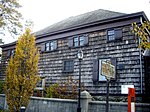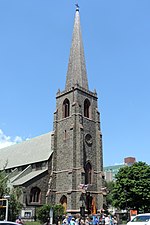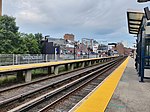The RKO Keith's Theater was an RKO Pictures movie theater at 129-43 Northern Boulevard in the Flushing neighborhood of Queens in New York City. It was designed by architect Thomas W. Lamb and built in 1928. While the RKO Keith's had a plain three-story facade, its interior was elaborately designed in a Spanish Baroque Revival style. The theater had a square ticket lobby and an oval grand foyer, which led to the double-level auditorium. The auditorium was designed as an atmospheric theater with a blue ceiling and gilded-plaster decorations; it contained 2,974 seats across two levels. There were also four lounges and a mezzanine promenade.
The theater was developed by Benjamin Franklin Keith and Edward Albee of the Keith–Albee vaudeville circuit, which bought the site in 1927. The Keith–Albee Theater, as it was known, opened on Christmas Day 1928 and originally operated as a vaudeville theater. In the 1930s, the theater was renamed the RKO Keith's and began showing movies. The theater continued to prosper after World War II in spite of a decline in New York City's large neighborhood movie palaces during that time. However, the RKO Keith's began to decline in the 1960s and was eventually divided into a three-screen multiplex in 1977. The RKO Keith's was added to the National Register of Historic Places in 1982. While the New York City Landmarks Preservation Commission (LPC) designated most of the theater as a New York City interior landmark in 1984, the New York City Board of Estimate curtailed the LPC's designation to cover only the ticket lobby and grand foyer.
Despite the landmark designations, the RKO Keith's closed after local developer Thomas Huang acquired the theater in 1986. Over the next three decades, it went through several efforts at redevelopment. After the theater was partially destroyed in 1987, Huang was forced to stop work on his project, and work stalled for over a decade. During this time, the RKO Keith's interior continued to deteriorate, and residents and politicians raised concerns over Huang's treatment of the theater. The RKO Keith's was sold to Shaya Boymelgreen in 2002, then to Patrick Thompson in 2010 and Jerry Karlik in 2014; all three men unsuccessfully tried to redevelop the site. After Chinese developers Xinyuan Real Estate bought the theater in 2016, most of the theater was finally demolished from 2020 to 2021. Xinyuan made plans to replace the theater with a condominium development, which would preserve the theater's ticket lobby and grand foyer.











